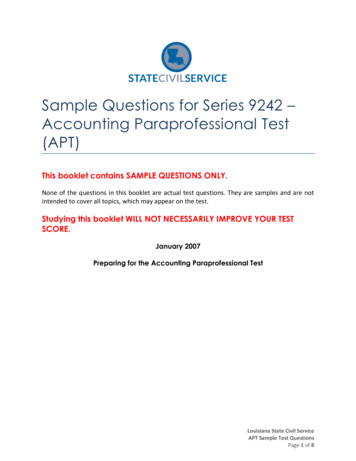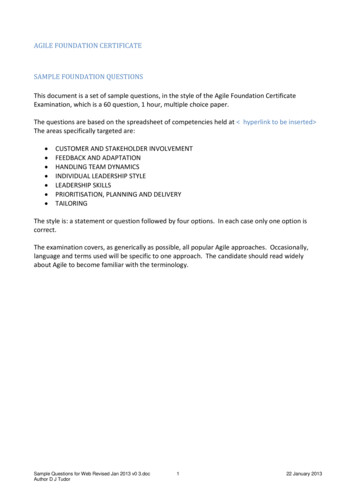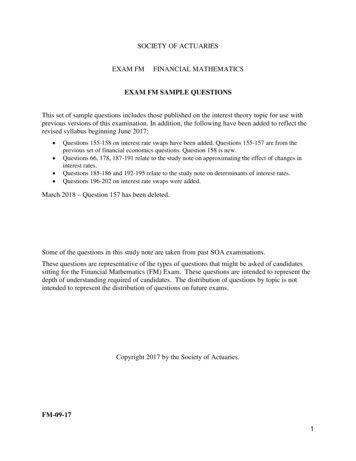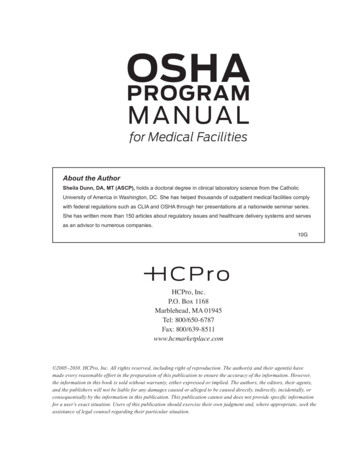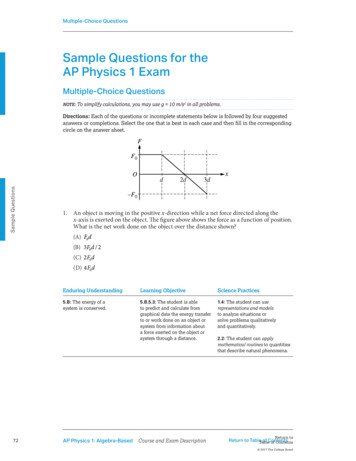
Transcription
Multiple-Choice QuestionsSample Questions for theAP Physics 1 ExamMultiple-Choice QuestionsNOTE: To simplify calculations, you may use g 10 m/s2 in all problems.Sample QuestionsDirections: Each of the questions or incomplete statements below is followed by four suggestedanswers or completions. Select the one that is best in each case and then fill in the correspondingcircle on the answer sheet.1. An object is moving in the positive x-direction while a net force directed along thex-axis is exerted on the object. The figure above shows the force as a function of position.What is the net work done on the object over the distance shown?(A)(B)(C)(D)72Enduring UnderstandingLearning ObjectiveScience Practices5.B: The energy of asystem is conserved.5.B.5.3: The student is ableto predict and calculate fromgraphical data the energy transferto or work done on an object orsystem from information abouta force exerted on the object orsystem through a distance.1.4: The student can userepresentations and modelsto analyze situations orsolve problems qualitativelyand quantitatively.AP Physics 1: Algebra-Based Course and Exam Description2.2: The student can applymathematical routines to quantitiesthat describe natural phenomena.Return toReturn to TableTableof Contentsof Contents 2017 The College Board
Multiple-Choice Questions2. The diagram above shows a top view of a child of mass M on a circular platform ofmass 2M that is rotating counterclockwise. Assume the platform rotates withoutfriction. Which of the following describes an action by the child that will increase theangular speed of the platform-child system and gives the correct reason why?(A) The child moves toward the center of the platform, increasing the total angularmomentum of the system.(C) The child moves away from the center of the platform, increasing the total angularmomentum of the system.(D) The child moves away from the center of the platform, decreasing the rotationalinertia of the system.Enduring UnderstandingLearning Objective5.E: The angular momentum of a 5.E.1.1: The student is able tosystem is conserved.make qualitative predictionsabout the angular momentum ofa system for a situation in whichthere is no net external torque.73Course and Exam Description AP Physics 1: Algebra-BasedSample Questions(B) The child moves toward the center of the platform, decreasing the rotational inertiaof the system.Science Practice6.4: The student can make claimsand predictions about naturalphenomena based on scientifictheories and models.Return toReturn to TableTableof Contentsof Contents 2017 The College Board73
Multiple-Choice Questions3. The figure above shows the forces exerted on a block that is sliding on a horizontalsurface: the gravitational force of 40 N, the 40 N normal force exerted by the surface, anda frictional force exerted to the left. The coefficient of friction between the block andthe surface is 0.20. The acceleration of the block is most nearlySample Questions(A)(B)(C)(D)Enduring UnderstandingsLearning ObjectivesScience Practices2.B: A gravitational field iscaused by an object with mass.2.B.1.1:! The! student is able toapply F mg to calculate thegravitational force on an objectwith mass m in a gravitationalfield of strength g in the contextof the effects of a net forceon objects and systems.1.4: The student can userepresentations and modelsto analyze situations orsolve problems qualitativelyand quantitatively.3.A: All forces share certaincommon characteristics whenconsidered by observers ininertial reference frames.3.B: Classically, the accelerationof an object interacting withother objects can be predictedby using.3.A.1.1: The student is able toexpress the motion of an objectusing narrative, mathematical,and graphical representations.1.5: The student can reexpresskey elements of naturalphenomena across multiplerepresentations in the domain.2.2: The student c an applymathematical routines toquantities that describenatural phenomena.3.B.1.3: The student is able toreexpress a free-body diagramrepresentation into a mathematical7.2: The student can connectrepresentation and solve theconcepts in and across domain(s)mathematical representation forto generalize or extrapolatethe acceleration of the object.in and/or across enduringunderstandings and/or big ideas.3.B.2.1: The student is able tocreate and use free-body diagramsto analyze physical situationsto solve problems with motionqualitatively and quantitatively.74AP Physics 1: Algebra-Based Course and Exam DescriptionReturn toReturn to TableTableof Contentsof Contents 2017 The College Board
Multiple-Choice QuestionsA student on another planet has two identical spheres, each of mass 0.6 kg, attached to theends of a rod of negligible mass. The student gives the assembly a rotation in the verticalplane and then releases it so it falls, as shown in the top figure above. Sensors record thevertical velocity of the two spheres, and the data is shown in the graph of velocity v as afunction of time t. Another student wants to calculate the assembly’s angular speed andthe change in the linear momentum of the center of mass of the assembly between 0 s and0.3 s. Which of these quantities can be determined using the graph?Sample Questions4.(A) Angular speed only(B) Change in linear momentum only(C) Angular speed and change in linear momentum(D) Neither of these quantities can be determined using the graph.Enduring UnderstandingsLearning Objectives3.F: A force exerted on an objectcan cause a torque on that object.3.F.2.2: The student is able toplan data collection and analysisstrategies designed to test the4.B: Interactions with other objectsrelationship between a torqueor systems can change the totalexerted on an object and thelinear momentum of a system.change in angular velocity ofthat object about an axis.Science Practice5.1: The student cananalyze data to identifypatterns or relationships.4.B.1.2: The student is able toanalyze data to find the change inlinear momentum for a constantmass system using the productof the mass and the change invelocity of the center of mass.75Course and Exam Description AP Physics 1: Algebra-BasedReturn toReturn to TableTableof Contentsof Contents 2017 The College Board75
Multiple-Choice Questions5.A block of known mass hanging from an ideal spring of known spring constant isoscillating vertically. A motion detector records the position, velocity, and acceleration ofthe block as a function of time. Which of the following indicates the measured quantitiesthat are sufficient to determine whether the net force exerted on the block equals thevector sum of the individual forces?Sample Questions(A) Acceleration only(B) Acceleration and position only(C) Acceleration and velocity only(D) Acceleration, position, and velocityEnduring UnderstandingLearning ObjectivesScience Practice3.B: Classically, the accelerationof an object interacting withother objects can be predicted3.B.1.2: The student is ableto design a plan to collect andanalyze data for motion (static,constant, or accelerating) fromforce measurements and carryout an analysis to determinethe relationship between thenet force and the vector sumof the individual forces.5.1: The student cananalyze data to identifypatterns or relationships.by using.3.B.3.3: The student can analyzedata to identify qualitative orquantitative relationships betweengiven values and variables (i.e.,force, displacement, acceleration,velocity, period of motion,frequency, spring constant, stringlength, mass) associated withobjects in oscillatory motionto use that data to determinethe value of an unknown.76AP Physics 1: Algebra-Based Course and Exam DescriptionReturn toReturn to TableTableof Contentsof Contents 2017 The College Board
Multiple-Choice Questions6. Block A hangs from a light string that passes over a light pulley and is attached toblock B, which is on a level horizontal frictionless table, as shown above. Students areto determine the mass of block B from the motion of the two-block system after it isreleased from rest. They plan to measure the time block A takes to reach the floor. Thestudents must also take which of the following measurements to determine the mass ofblock B?(B) Only the distance block A falls to reach the floor(C) Only the mass of block A and the distance block A falls to reach the floor(D) The mass of block A, the distance block A falls to reach the floor, and the radius ofthe pulleyEnduring UnderstandingsLearning ObjectivesScience Practices3.A: All forces share certaincommon characteristics whenconsidered by observers ininertial reference frames.3.A.1.2: The student is ableto design an experimentalinvestigation of themotion of an object.4.2: The student can designa plan for collecting datato answer a particularscientific question.4.A: The acceleration of thecenter of mass of a system isrelated to the net force exerted4.A.2.1: The student is ableto make predictions about themotion of a system based on thefact that acceleration is equal tothe change in velocity per unittime, and velocity is equal to thechange in position per unit time.6.4: The student can makeclaims and predictions aboutnatural phenomena based onscientific theories and models.on the system, where77.Course and Exam Description AP Physics 1: Algebra-BasedReturn toReturn to TableTableof Contentsof Contents 2017 The College BoardSample Questions(A) Only the mass of block A77
Multiple-Choice Questions7.Two objects are released from rest at the top of ramps with the same dimensions, asshown in the figure above. The sphere rolls down one ramp without slipping. The smallblock slides down the other ramp without friction. Which object reaches the bottom ofits ramp first, and why?(A) The sphere, because it gains rotational kinetic energy, but the block does notSample Questions(B) The sphere, because it gains mechanical energy due to the torque exerted on it, butthe block does not78(C) The block, because it does not lose mechanical energy due to friction, but the spheredoes(D) The block, because it does not gain rotational kinetic energy, but the sphere doesEnduring UnderstandingLearning ObjectivesScience Practices5.B: The energy of asystem is conserved.5.B.4.2: The student is able tocalculate changes in kineticenergy and potential energy of asystem using information fromrepresentations of that system.1.4: The student can userepresentations and modelsto analyze situations orsolve problems qualitativelyand quantitatively.5.B.5.4: The student is ableto make claims about theinteraction between a systemand its environment in whichthe environment exerts a forceon the system, thus doing workon the system and changing theenergy of the system (kineticenergy plus potential energy).6.4: The student can makeclaims and predictions aboutnatural phenomena based onscientific theories and models.AP Physics 1: Algebra-Based Course and Exam DescriptionReturn toReturn to TableTableof Contentsof Contents 2017 The College Board
Multiple-Choice QuestionsTwo blocks, of mass m and 2m, are initially at rest on a horizontal frictionless surface.A force F is exerted individually on each block, as shown above. The graph shows how Fvaries with time t. Which block has the greatest average power provided to it betweenand?(A) The block of mass m(B) The block of mass 2mSample Questions8.(C) Both blocks have the same power provided to them.(D) It cannot be determined without knowing the ratio of the maximum force to themass m.79Enduring UnderstandingsLearning ObjectivesScience Practices3.A: All forces share certaincommon characteristics whenconsidered by observers ininertial reference frames.3.A.1.1: The student is able toexpress the motion of an objectusing narrative, mathematical,and graphical representations.3.E: A force exerted on an objectcan change the kinetic energy ofthe object.3.E.1.4: The student is able toapply mathematical routines todetermine the change in kineticenergy of an object given theforces on the object and thedisplacement of the object.1.4: The student can userepresentations and modelsto analyze situations orsolve problems qualitativelyand quantitatively.Course and Exam Description AP Physics 1: Algebra-Based1.5: The student can reexpresskey elements of natural phenomenaacross multiple representations inthe domain.Return toReturn to TableTableof Contentsof Contents 2017 The College Board79
Multiple-Choice QuestionsEnduring UnderstandingsLearning ObjectivesScience Practices5.B: The energy of asystem is conserved.5.B.5.3: The student is ableto predict and calculate fromgraphical data the energy transferto or work done on an object orsystem from information abouta force exerted on the object orsystem through a distance.2.2: The student can applymathematical routines toquantities that describe naturalphenomena.Sample Questions5.B.5.5: The student is ableto predict and calculate theenergy transfer to (i.e., thework done on) an object orsystem from information abouta force exerted on the object orsystem through a distance.6.4: The student can makeclaims and predictions aboutnatural phenomena based onscientific theories and models.80AP Physics 1: Algebra-Based Course and Exam DescriptionReturn toReturn to TableTableof Contentsof Contents 2017 The College Board
Multiple-Choice Questions9. A moon is in an elliptical orbit about a planet as shown above. At point A the moonhas speedand is at distancefrom the planet. At point B the moon has speed.Which of the following explains a correct method for determining the distance of themoon from the planet at point B in terms of the given quantities?(A) Conservation of angular momentum, because the gravitational force exerted by themoon on the planet is the same as that exerted by the planet on the moon(B) Conservation of angular momentum, because the gravitational force exerted on themoon is always directed toward the planet(D) Conservation of energy, because the gravitational force exerted by the moon on the planetis the same as that exerted by the planet on the moonEnduring UnderstandingsLearning ObjectivesScience Practices5.B: The energy of asystem is conserved.5.B.5.4: The student is ableto make claims about theinteraction between a systemand its environment in whichthe environment exerts a forceon the system, thus doing workon the system and changing theenergy of the system (kineticenergy plus potential energy).6.4: The student can makeclaims and predictions aboutnatural phenomena based onscientific theories and models.5.E: The angular momentumof a system is conserved.5.E.1.1: The student is able tomake qualitative predictionsabout the angular momentum ofa system for a situation in whichthere is no net external torque.81Course and Exam Description AP Physics 1: Algebra-BasedSample Questions(C) Conservation of energy, because the gravitational force exerted on the moon isalways directed toward the planet7.2: The student can connectconcepts in and acrossdomain(s) to generalize orextrapolate in and/or acrossenduring understandingsand/or big ideas.Return toReturn to TableTableof Contentsof Contents 2017 The College Board81
Multiple-Choice QuestionsQuestions 10 –12 refer to the following material.Block 1 of mass and block 2 of mass are sliding along the same line on a horizontalfrictionless surface when they collide at time . The graph above shows the velocities of theblocks as a function of time.Sample Questions10. Which block has the greater mass, and what information indicates this?(A) Block 1, because it had a greater speed before the collision.(B) Block 1, because the velocity after the collision is in the same direction as its velocitybefore the collision.(C) Block 2, because it had a smaller speed before the collision.(D) Block 2, because the final velocity is closer to the initial velocity of block 2 than it is tothe initial velocity of block 1.Enduring UnderstandingsLearning ObjectivesScience Practices4.A: The acceleration of thecenter of mass of a system isrelated to the net force exerted4.A.2.3: The student is able tocreate mathematical models andanalyze graphical relationshipsfor acceleration, velocity, andposition of the center of mass of asystem and use them to calculateproperties of the motion of thecenter of mass of a system.1.4: The student can userepresentations and modelsto analyze situations orsolve problems qualitativelyand quantitatively.on the system, where5.D: The linear momentumof a system is conserved.5.D.2.5: The student is able toclassify a given collision situationas elastic or inelastic, justifythe selection of conservationof linear momentum as theappropriate solution method foran inelastic collision, recognizethat there is a common finalvelocity for the colliding objectsin the totally inelastic case,solve for missing variables,and calculate their values.82AP Physics 1: Algebra-Based Course and Exam Description2.2: The student can applymathematical routines toquantities that describenatural phenomena.Return toReturn to TableTableof Contentsof Contents 2017 The College Board
Multiple-Choice Questions11. How does the kinetic energy of the two-block system after the collision compare with itskinetic energy before the collision, and why?(A) It is less, because the blocks have the same velocity after the collision, so some of theirkinetic energy was transformed into internal energy.(B) It is less, because the blocks have velocities in opposite directions before the collision,so some of their kinetic energy cancels.(C) It is the same, because the collision was instantaneous, so the effect of external forcesduring the collision is negligible.(D) It is the same, because the blocks have the same velocity after the collision, and thereis no friction acting on them.Learning ObjectiveScience Practices5.D: The linear momentumof a system is conserved.5.D.2.3: The student is ableto apply the conservation oflinear momentum to a closedsystem of objects involved inan inelastic collision to predictthe change in kinetic energy.6.4: The student can makeclaims and predictions aboutnatural phenomena based onscientific theories and models.Course and Exam Description AP Physics 1: Algebra-Based7.2: The student can connectconcepts in and across domain(s)to generalize or extrapolatein and/or across enduringunderstandings and/or big ideas.Return toReturn to TableTableof Contentsof Contents 2017 The College BoardSample Questions83Enduring Understanding83
Multiple-Choice Questions12. Which of the following is true of the motion of the center of mass of the two-blocksystem during the time shown?(A) The center of mass does not move because the blocks are moving in oppositedirections before the collision.(B) The center of mass moves at a constant velocity offriction acting on the system.because there is no(C) The center-of-mass velocity starts out greater thanbut decreases toduring the collision because the collision is inelastic.(D) The center-of-mass velocity increases as the blocks get closer together, and thenbecomes constant after the collision.Enduring UnderstandingLearning ObjectiveScience Practices4.A: The acceleration of thecenter of mass of a system isrelated to the net force exerted4.A.2.3: The student is able tocreate mathematical models andanalyze graphical relationshipsfor acceleration, velocity, andposition of the center of mass of asystem and use them to calculateproperties of the motion of thecenter of mass of a system.1.4: The student can userepresentations and modelsto analyze situations orsolve problems qualitativelyand quantitatively.Sample Questionson the system, where84.AP Physics 1: Algebra-Based Course and Exam Description2.2: The student can applymathematical routines to quantitiesthat describe natural phenomena.Return toReturn to TableTableof Contentsof Contents 2017 The College Board
Multiple-Choice QuestionsQuestions 13 –15 refer to the following information.13. Which of the following correctly ranks the magnitude of the average acceleration of thecart during the four sections of the graph?Sample QuestionsA cart is constrained to move along a straight line. A varying net force along thedirection of motion is exerted on the cart. The cart’s velocity v as a function of time t isshown in the graph above. The five labeled points divide the graph into four sections.(A)(B)(C)(D)85Enduring UnderstandingLearning ObjectivesScience Practices3.A: All forces share certaincommon characteristics whenconsidered by observers ininertial reference frames.3.A.1.1: The student is able toexpress the motion of an objectusing narrative, mathematical,and graphical representations.1.5: The student can reexpresskey elements of naturalphenomena across multiplerepresentations in the domain.3.A.1.3: The student is ableto analyze experimental datadescribing the motion of anobject and is able to expressthe results of the analysis usingnarrative, mathematical, andgraphical representations.2.2: The student can applymathematical routines toquantities that describenatural phenomena.Course and Exam Description AP Physics 1: Algebra-BasedReturn toReturn to TableTableof Contentsof Contents 2017 The College Board85
Multiple-Choice Questions14. For which segment does the cart move the greatest distance?(A) AB(B) BC(C) CD(D) DEEnduring UnderstandingLearning ObjectiveScience Practices3.A: All forces share certaincommon characteristics whenconsidered by observers ininertial reference frames.3.A.1.1: The student is able toexpress the motion of an objectusing narrative, mathematical,and graphical representations.1.5: The student can reexpresskey elements of natural phenomenaacross multiple representations inthe domain.Sample Questions2.2: The student can applymathematical routines toquantities that describenatural phenomena.86AP Physics 1: Algebra-Based Course and Exam DescriptionReturn toReturn to TableTableof Contentsof Contents 2017 The College Board
Multiple-Choice Questions15. During some part of the motion, the work done on the cart is negative. What feature ofthe motion indicates this?(A) The speed is increasing.(B) The speed is decreasing.(C) The acceleration is positive.(D) The acceleration is negative.Enduring UnderstandingsLearning ObjectivesScience Practices3.E: A force exerted on anobject can change the kineticenergy of the object.3.E.1.3: The student is able touse force and velocity vectorsto determine qualitatively orquantitatively the net force exertedon an object and qualitativelywhether kinetic energy of thatobject would increase, decrease,or remain unchanged.1.4: The student can userepresentations and modelsto analyze situations orsolve problems qualitativelyand quantitatively.5.B: The energy of asystem is conserved.87Course and Exam Description AP Physics 1: Algebra-Based6.4: The student can makeclaims and predictions aboutnatural phenomena based onscientific theories and models.7.2: The student can connectconcepts in and across domain(s)to generalize or extrapolatein and/or across enduringunderstandings and/or big ideas.Return toReturn to TableTableof Contentsof Contents 2017 The College BoardSample Questions5.B.5.4: The student is ableto make claims about theinteraction between a systemand its environment in whichthe environment exerts a forceon the system, thus doing workon the system and changing theenergy of the system (kineticenergy plus potential energy).2.2: The student can applymathematical routines toquantities that describenatural phenomena.87
Multiple-Choice QuestionsSample Questions16. The figure above shows a block on a horizontal surface attached to two springs whoseother ends are fixed to walls. A light string attached to one side of the block initially liesstraight across the surface, as shown. The other end of the string is free to move. Thereis significant friction between the block and the surface but negligible friction betweenthe string and the surface. The block is displaced a distance d and released from rest.Which of the following best represents the shape of the string a short time later?88AP Physics 1: Algebra-Based Course and Exam DescriptionReturn toReturn to TableTableof Contentsof Contents 2017 The College Board
Multiple-Choice QuestionsEnduring UnderstandingsLearning ObjectivesScience Practices3.B: Classically, the accelerationof an object interacting withother objects can be predicted3.B.3.1: The student is ableto predict which propertiesdetermine the motion of asimple harmonic oscillator andwhat the dependence of themotion is on those properties.1.4: The student can userepresentations and modelsto analyze situations orsolve problems qualitativelyand quantitatively.by using.4.C: Interactions with otherobjects or systems can changethe total energy of a system.6.A: A wave is a travelingdisturbance that transfersenergy and momentum.4.C.2.1: The student is ableto make predictions about thechanges in the mechanicalenergy of a system when acomponent of an external forceacts parallel or antiparallel tothe direction of the displacementof the center of mass.6.4: The student can makeclaims and predictions aboutnatural phenomena based onscientific theories and models.7.2: The student can connectconcepts in and across domain(s)to generalize or extrapolatein and/or across enduringunderstandings and/or big ideas.6.A.3.1: The student is able touse graphical representationof a periodic mechanicalwave to determine theamplitude of the wave.Sample Questions89Course and Exam Description AP Physics 1: Algebra-BasedReturn toReturn to TableTableof Contentsof Contents 2017 The College Board89
Multiple-Choice Questions17. Two massive, positively charged particles are initially held a fixed distance apart. Whenthey are moved farther apart, the magnitude of their mutual gravitational force changesby a factor of n. Which of the following indicates the factor by which the magnitude oftheir mutual electrostatic force changes?(A)(B)(C) nSample Questions(D)90Enduring UnderstandingLearning ObjectivesScience Practices3.C: At the macroscopic level,forces can be categorized aseither long-range (action-at-adistance) forces or contact forces.3.C.2.1: The student is able touse Coulomb’s law qualitativelyand quantitatively to makepredictions about the interactionbetween two electric pointcharges (interactions betweencollections of electric pointcharges are not covered inPhysics 1 and instead arerestricted to Physics 2).6.4: The student can makeclaims and predictions aboutnatural phenomena based onscientific theories and models.7.2: The student can connectconcepts in and across domain(s)to generalize or extrapolatein and/or across enduringunderstandings and/or big ideas.3.C.2.2: The student is ableto connect the concepts ofgravitational force and electricforce to compare similarities anddifferences between the forces.AP Physics 1: Algebra-Based Course and Exam DescriptionReturn toReturn to TableTableof Contentsof Contents 2017 The College Board
Multiple-Choice Questions18. The circuit shown above contains two resistors of resistance R and 2R. The graph showsthe total energy E dissipated by the smaller resistance as a function of time. Whichof the following shows the corresponding graph for the larger resistance?Sample Questions91Course and Exam Description AP Physics 1: Algebra-BasedReturn toReturn to TableTableof Contentsof Contents 2017 The College Board91
Multiple-Choice QuestionsEnduring UnderstandingLearning ObjectivesScience Practices5.B: The energy of asystem is conserved.5.B.9.1: The student is able toconstruct or interpret a graphof the energy changes withinan electrical circuit with only asingle battery and resistors inseries and/or in, at most, oneparallel branch as an applicationof the conservation of energy(Kirchhoff’s loop rule).1.1: The student can createrepresentations and models ofnatural or man-made phenomenaand systems in the domain.6.4: The student can makeclaims and predictions aboutnatural phenomena based onscientific theories and models.7.2: The student can connectconcepts in and across domain(s)to generalize or extrapolatein and/or across enduringunderstandings and/or big ideas.Sample Questions5.B.9.3: The student is able toapply conservation of energy(Kirchhoff’s loop rule) incalculations involving the totalelectric potential differencefor complete circuit loopswith only a single battery andresistors in series and/or in,at most, one parallel branch.1.4: The student can userepresentations and modelsto analyze situations orsolve problems qualitativelyand quantitatively.92AP Physics 1: Algebra-Based Course and Exam DescriptionReturn toReturn to TableTableof Contentsof Contents 2017 The College Board
Multiple-Choice Questions19. A student connects one end of a string with negligible mass to an oscillator. The otherend of the string is passed over a pulley and attached to a suspended weight, as shownabove. The student finds that a standing wave with one antinode is formed on the stringwhen the frequency of the oscillator is f0 . The student then moves the oscillator toshorten the horizontal segment of string to half its original length. At what frequencywill a standing wave with one antinode now be formed on the string?(A)(B) f0Sample Questions(C)(D) There is no frequency at which a standing wave will be formed.93Enduring UnderstandingLearning ObjectiveScience Practice6.D: Interference andsuperposition lead tostanding waves and beats.6.D.4.2: The student is ableto calculate wavelengths andfrequencies (if given wave speed)of standing waves based onboundary conditions and lengthof region within which thewave is confined, and calculatenumerical values of wavelengthsand frequencies. Examplesinclude musical instruments.2.2: The student can applymathematical routines toquantities that describenatural phenomena.Course and Exam Description AP Physics 1: Algebra-BasedReturn toReturn to TableTableof Contentsof Contents 2017 The College Board93
Multiple-Choice Questions20. The figure above shows a portion of a periodic wave on a str
Multiple-Choice Questions Sample Questions AP Physics 1: Algebra-Based72 Course and Exam Description Sample Questions for the AP Physics 1 Exam Multiple-Choice Questions NOTE: To simplify calculations, you may use g 10 m/s2 in all problems. Directions: Each of the questions or incomplete statements below is followed by four suggested answers or completions.





